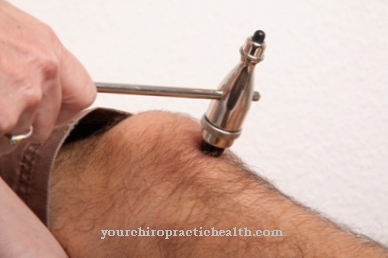The term Extension is used in anatomical nomenclature to describe movement. It describes one of the main movements of the human body.
What is the extension?

The extension, in German Elongation, like its countermovement, flexion, occurs in many limb joints and on the spine. The original definition of the terms in the anatomical nomenclature was based on the embryonic position model. Accordingly, the extension is defined as the movement that leads out of this position.
There are extension movements in the large limb joints, above in the shoulder and elbow, below in the hip and knee, and in the toe and finger joints. The extension of the spine takes place as a single movement in the vertebral joints of the individual segments. In descriptions and documentation, however, the overall movement or the behavior of a movement section are often described. Physiologically, the lumbar spine and the cervical spine are already in an extension position called lordosis at rest.
With one exception, the range of motion of extension is smaller than that of flexion in all joints. The metatarsophalangeal joints alone can be stretched more than they can be bent. In many people, active extension of the knee and elbow joint is not possible; often only the zero position is reached.
Function & task
Extension is involved in the stance phase in all the joints of the lower extremity, albeit in different sub-phases and with different functions. While the toes are raised right at the beginning when the foot is put down, the knee joint only reaches full extension in the middle and the hip joint at the end of the sequence of movements.
When jumping or overcoming a height, the activity of the extensor muscles in the hip and knee joint is significantly increased. With the gluteus maximus muscle, the quadriceps femoris muscle and the triceps surae, 3 of the strongest muscles in the human body are available. In the free chain, extension activities in the knee can be observed when kicking or shooting, as in martial arts or soccer. Accented extensions of the hip joint are common in ballet and floor exercises.
On the arm, the extension plays an important role in stabilization requirements and free movements. Support activities in front of the body, such as supporting at the table or on the thighs, primarily require active extension of the elbow. A typical strength exercise for this is the push-up. When supporting behind the body, shoulder extension is also switched on. The corresponding form of exercise in sport are dips in different versions.
In functional anatomy, the return from a flexed position is often referred to as extension. There are many movements on the arm in sport and in normal everyday life, which are precisely shaped by these components in the elbow and shoulder joint. Slashes in volleyball, overhead hits in tennis, throws in handball or return movements in all types of swimming include the simultaneous extension of the shoulder and elbow as important elements.
The extension of the finger joints is important as a counter process to the closing of the hand. In order to be able to grasp or edit something in a targeted manner, the fingers must be opened beforehand. The finger joints are also stretched during backward movements before a stroke.
The extension of the spine is an important component of straightening the trunk, such as when lifting heavy loads. The free extension can be observed in some sports such as gymnastics, ballet, swimming or high diving.
You can find your medication here
➔ Medicines for painIllnesses & ailments
Degenerative diseases like osteoarthritis can basically affect all joints. Typically, this condition occurs more where loads act, such as in the hip and knee joints and on the spine. The extension can be affected by several arthritic processes. On the one hand, the joint capsule shrinks over time, which directly restricts extension. On the other hand, the pain that occurs leads to a gentle behavior that leads to a weakening and shortening of the muscles. In this case, the movement amplitude is negatively influenced both actively and passively. The limited extension in the hip joint has a direct impact on the gait pattern.
Any kind of muscle breakdown can also limit stretching. As a rule, activities that are carried out against gravity, such as straightening up from a stooped or crouched position or holding the legs in a standing position, are affected first. Muscle loss can be the result of inactivity or illness. Muscular dystrophies and amyotrophic lateral sclerosis belong to this group.
Specific neurological diseases and damage can have a negative impact on the proper functioning of the extensors. In multiple sclerosis, the correct, targeted movement and stability are among other things affected. Coordination and stability problems arise as a result, especially when walking and standing.
A lesion of the femoral nerve leads to partial paralysis of the quadriceps femoris muscle, which greatly affects stability when standing and walking. The same problem can occur in the upper extremity when the radial nerve is damaged by an upper arm fracture. This supplies, among other things, the triceps brachii muscle, the main extensor in the elbow. If this muscle fails, the elbow can only be stretched rudimentarily and supporting loads are no longer possible.
The supraspinatus tendon syndrome is a special disease in the shoulder joint that particularly affects the extension. The supraspinatus muscle is a shoulder muscle that belongs to the rotator cuff. Its tendon runs in a narrow space between the roof of the shoulder and the joint head. Repeated pressure loads can irritate the muscle. The return of the arm, especially in combination with internal rotation, is often painfully restricted as a result.












.jpg)



.jpg)










.jpg)
